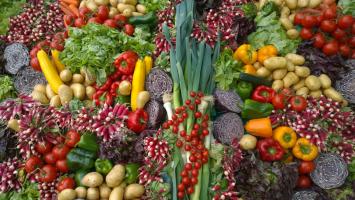![Save this Recipe. Save this Recipe]() Save Save
How to Make Cultured Cashew CheeseSERVINGS: 4 PREP TIME: 10 MINUTES COOK TIME: 0 MINUTES
PREPARATION OF THIS HEALTHY RECIPE
1. Soak cashews overnight.
2. In the morning, drain soak water and rinse cashews. Blend in high powered food processor until completely smooth. You may need to add 1-2tbsp of water.
2. Add yogurt and salt and blend once more to combine, scraping down the sides as needed.
3. Leave to set for 24 hours in a clean air-tight container at room temperature.
How Does This Ayurvedic Recipe Improve Wellness?
CLINICAL AYURVEDIC REVIEW
'Cultured Cashew Cheese' may sound like a handful, but it's surprisingly simple. With just two main ingredients (plus a pinch of salt and a drop of water!) you can create this creamy, tangy spread. Those who are intimidated by culturing (aka fermenting), foods can rest easy. This vegan friendly option is a perfect starting point for beginners. Get Some Good BacteriaThe process of culturing occurs when bacteria, such as lactobacilli, feeds on sugar as its energy source creating lactic acid. Culturing the cashews in this way with coconut yogurt preserves the vital nutrients, creates enzymes which aid digestibility and puts those all important probiotics back into your digestive system, creating a blooming gut flora. You'll feel vibrant and well year round. Fermenting FoodsAyurveda has a strong tradition of enjoying fermented foods including wines, chutneys and the all important digestive lassi. In excess, fermented foods can create a dull, heavy feeling in the body due to length of time the food has been fermenting. But in the right quantities, fermented foods boost vitality, energy and are sattvic in nature, promoting clarity and lightness of body and mind.
This recipes makes a smooth blend. You can make a firmer 'Cashew Cultured Cheese' by straining out the excess water with a cheese cloth. Mix and match your favourite herbs and spices to create a whole new cheese each batch. Make sure to get the unsweetened, unflavored coconut yoghurt to achieve the desired result.
AYURVEDA'S GUIDE TO VITALITY & WHOLESOME NOURISHMENT
Your Ayurvedic diet is tailored to your individual body and your specific imbalances.
With an Ayurvedic diet you feel joy and satisfaction because what you are eating truly nourishes and balances you.
Disease results from diets and lifestyles that are incompatible with your nature.
By eating a personalized diet matched to your body, you experience optimal health.
See How it Works.
Is Cultured Cashew Cheese Good for My Ayurvedic Diet?
Find out by taking this free, easy quiz.
You'll learn your body type, and whether 'Cultured Cashew Cheese' is a good fit.
Complete the basic quiz in 1 minute, or go deeper with additional quizzes at your own leisure to learn more about your body.
See a complete list of all biocharacteristics.
INCREASES![Guna Help]()
Increases These Biocharacteristics (Gunas)
Functional Ayurveda helps you assess imbalances through 20 main biocharacteristics
(gunas).
Aggravating these characteristics weakens your body and causes imbalance.
By knowing which characteristics are habitually imbalanced in your body, you will be able to identify and correct imbalances before you get sick.
Every characteristic has an opposite which balances it (i.e. hot balances cold).
You restore balance by favoring diet and lifestyle choices that increase the opposite characteristic.
Learn More
| HOT ![Hot Hot]() ABOUT HOT BIOCHARACTERISTIC ABOUT HOT BIOCHARACTERISTIC
Hot is identified by increased body temperature, metabolism, or inflammation.
LEARN MORE ABOUT HOT HEAVY ![Heavy Heavy]() ABOUT HEAVY BIOCHARACTERISTIC ABOUT HEAVY BIOCHARACTERISTIC
Heavy is identified by sedation, sluggishness, or increased weight.
LEARN MORE ABOUT HEAVY DRY ![Dry Dry]() ABOUT DRY BIOCHARACTERISTIC ABOUT DRY BIOCHARACTERISTIC
Dry is identified by lack of moisture, lack of fat, or anything that causes diuresis.
LEARN MORE ABOUT DRY DIFFICULT ![Difficult Difficult]() ABOUT DIFFICULT BIOCHARACTERISTIC ABOUT DIFFICULT BIOCHARACTERISTIC
Difficult refers to anything that is difficult to digest, or takes a long time to digest.
LEARN MORE ABOUT DIFFICULT | TASTES![Taste Help]()
The 6 Tastes
Taste is used to sense the most basic properties and effects of food.
Each taste has a specific medicinal effect on your body.
Cravings for food with certain tastes indicate your body is craving specific medicinal results from food.
Taste is experienced on the tongue and represents your body's reaction to foods.
Sweet taste causes physical satisfaction and attraction whereas bitter taste causes discomfort and aversion.
Kapha should use less sweet taste while Vata and Pitta would benefit from using more sweet taste.
One of the first signs of illness is that your taste and appetite for food changes.
The six tastes are sweet, sour, salty, pungent, bitter, and astringent.
Do you crave foods with any of the tastes below?
Learn More
| SWEET ![Sweet Sweet]() ABOUT SWEET BIOCHARACTERISTIC ABOUT SWEET BIOCHARACTERISTIC
Sweet refers to anything builds tissue, including macronutrients such as carbohydrates, proteins and fats.
LEARN MORE ABOUT SWEET | DOSHAS![Dosha Help]()
The Three Doshas / Body Types
According to the biocharacteristic theory of medicine,
people tend to get sick, over and over again, due to habitual causes and imbalances that are unique to the person.
Your body type summarizes this tendency, showing you the 'type' of conditions and imbalances that frequently challenge your health & wellness.
Using body type, you can also identify remedies likely to improve your strength and resiliency.
Your body type identifies physical and mental characteristics as well as your personal strengths and weaknesses.
The calculation of your body type is based on your medical history.
The 3 functional body types
(doshas),
are Catabolic (Vata), Metabolic (Pitta), and Anabolic (Kapha).
Catabolic individuals tend to break down body mass into energy. They are easily stimulated, hyperactive, underweight and dry.
Metabolic individuals tend to burn or use energy. They tend to be rosy-cheeked, easily irritated, focused, driven, and easily inflamed.
Anabolic individuals tend to store energy as body mass. If they store too much energy, they could gain weight easily and have congestion. Anabolic people tend to be stable and grounded.
Learn More
| |
|
Medicinal Benefits, Uses & Herbal Actions of Cultured Cashew Cheese ![Help]() Experiences are Personal
Experiences vary according to the person and constitution. Individual results may vary.
The list of herbal-actions below has not be approved by the FDA and should not be used to treat a medical condition.
|
Foods with a Similar Nature to Cultured Cashew Cheese
Cashews
Cashews has these Actions in Common
Satisfies-stomach, Builds-stamina, Nutritive
LEARN MORE
Chestnuts
Chestnuts has these Actions in Common
Nutritive, Satisfies-stomach, Builds-stamina
LEARN MORE
Pecans
Pecans has these Actions in Common
Satisfies-stomach, Builds-stamina, Nutritive
LEARN MORE
Pine Nuts
Pine Nuts has these Actions in Common
Builds-stamina, Nutritive, Satisfies-stomach
LEARN MORE
Brazil Nut
Brazil Nut has these Actions in Common
Nutritive, Satisfies-stomach, Builds-stamina
LEARN MORE
Chicken Liver
Chicken Liver has these Actions in Common
Satisfies-stomach, Builds-stamina, Nutritive
LEARN MORE
Lamb's Quarters
Lamb's Quarters has these Actions in Common
Satisfies-stomach, Builds-stamina, Nutritive
LEARN MORE
Almond Butter
Almond Butter has these Actions in Common
Satisfies-stomach, Builds-stamina, Nutritive
LEARN MORE
Oat Flour
Oat Flour has these Actions in Common
Satisfies-stomach, Builds-stamina, Nutritive
LEARN MORE
Walnuts
Walnuts has these Actions in Common
Builds-stamina, Nutritive, Satisfies-stomach
LEARN MORE
Quinoa
Quinoa has these Actions in Common
Nutritive, Satisfies-stomach, Builds-stamina
LEARN MORE
Herb Supplements with a Similar Nature to Cultured Cashew Cheese
Maca
Maca has these Actions in Common
Builds-stamina, Nutritive
LEARN MORE
Bala
Bala has these Actions in Common
Builds-stamina, Nutritive
LEARN MORE
Ginseng, Chinese
Ginseng, Chinese has these Actions in Common
Builds-stamina, Nutritive
LEARN MORE
Ashwagandha
Ashwagandha has these Actions in Common
Nutritive, Builds-stamina
LEARN MORE
Cordyceps
Cordyceps has these Actions in Common
Nutritive
LEARN MORE
CoQ10
CoQ10 has these Actions in Common
Builds-stamina
LEARN MORE
Asparagus root
Asparagus root has these Actions in Common
Nutritive
LEARN MORE
Sukumaram Ghrita
Sukumaram Ghrita has these Actions in Common
Nutritive
LEARN MORE
Slippery Elm
Slippery Elm has these Actions in Common
Nutritive
LEARN MORE
Sea buckthorn
Sea buckthorn has these Actions in Common
Nutritive
LEARN MORE
Find a true source of hope
Find a true source of hope has these Actions in Common
Builds-stamina
LEARN MORE
![]()
Joyful Belly is a recognized school of biocharacteristics medicine.
Eat Well for Life With Ayurveda: Balance Your Dosha
Love our recipes? Discover how to balance your diet for only $35 with this popular short course.
GET THE ECOURSE
![About John Joseph Immel]()
About the Author
John Immel, the founder of Joyful Belly, teaches people how to have a
healthy diet and lifestyle with Ayurveda biocharacteristics.
His approach to Ayurveda is clinical, yet exudes an ease which many find enjoyable and insightful.
John also directs Joyful Belly's School of Ayurveda,
offering professional clinical training in Ayurveda for over 15 years.
John's interest in Ayurveda and specialization in digestive tract pathology was inspired by a complex digestive disorder acquired from years of international travel,
as well as public service work in South Asia.
John's commitment to the detailed study of digestive disorders reflects his zeal to get down to the roots of the problem.
His hope and belief in the capacity of each & every client to improve their quality of life is nothing short of a personal passion.
John's creativity in the kitchen and delight in cooking for others comes from his family oriented upbringing.
In addition to his certification in Ayurveda, John holds a bachelor's degree in mathematics from Harvard University.
John enjoys sharing Ayurveda within the context of his Catholic roots,
and finds Ayurveda gives him an opportunity to participate in the healing mission of the Church.
Jesus expressed God's love by feeding and healing the sick.
That kindness is the fundamental ministry of Ayurveda as well.
Outside of work, John enjoys spending time with his wife and 6 kids, and pursuing his love of theology, philosophy, and language.
Read more
Comments & Impressions of 'Cultured Cashew Cheese'
Do you like 'cultured cashew cheese'?
Why or why not?
What makes it unique? Is there something else you'd like to know about 'cultured cashew cheese'?
![full start review]() ![full start review]() ![full start review]() ![full start review]() ![full start review]() (5.00 out of 5 stars) 2 ratings, 170 likes (5.00 out of 5 stars) 2 ratings, 170 likes![blank start review]() ![blank start review]() ![blank start review]() ![blank start review]() ![blank start review]() Sign in to review this recipe Sign in to review this recipe
It reminds me of Ricotta cheese!!!!!! How quickly should it be consumed?
Fermented foods generally last longer. We suggest using it within 7 days.
Perfect, thank you!
- Daniela Friedrich, Albuquerque, NM , 05-01-17 ( Reply) |

 Save
Save




 2 ratings, 170 likes
2 ratings, 170 likes




 Sign in to review this recipe
Sign in to review this recipe











 Print
Print
 On MeWe
On MeWe On Pinterest
On Pinterest On Facebook
On Facebook On Twitter
On Twitter On WhatsApp
On WhatsApp On Email
On Email











